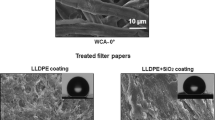Abstract
In this study, a novel method including the concurrent use of nanoparticles and non-solvent is proposed for surface modification of filter papers with the aim of achieving superhydrophobicity that can be used in oil/water separation applications. The effects of polymer, nanoparticle and non-solvent contents were investigated on the surface morphology, composition and wettability of the samples. A comparison was also made between the solution casting and dip-coating techniques. It was found that the dip-coating technique was not as efficient as solution casting because of the lower adsorption of polystyrene macromolecules onto the papers’ surfaces. Scanning electron microscopy results demonstrated the role of non-solvent in the surface morphology of the coatings. In fact, in the absence of non-solvent, superhydrophobicity was not achieved. X-ray photoelectron spectroscopy results confirmed that the presence of non-solvent also changed the surface composition of the coatings significantly. The optimum composition was found to have promising potentials in the separation of oil from water because of the induced superhydrophobic and superoleophilic properties. The findings of this fundamental research could be exploited in other systems for more efficient oil/water separating devices.







Similar content being viewed by others
References
Arbatan T, Zhang L, Fang X-Y, Shen W (2012) Cellulose nanofibers as binder for fabrication of superhydrophobic paper. Chem Eng J 210:74–79
Böhm A, Gattermayer M, Trieb C et al (2013) Photo-attaching functional polymers to cellulose fibers for the design of chemically modified paper. Cellulose 20:467–483
Chen D, Chen F, Zhang H et al (2016) Preparation and characterization of novel hydrophobic cellulose fabrics with polyvinylsilsesquioxane functional coatings. Cellulose 23:941–953
Du C, Wang J, Chen Z, Chen D (2014) Durable superhydrophobic and superoleophilic filter paper for oil–water separation prepared by a colloidal deposition method. Appl Surf Sci 313:304–310
Feng L, Zhang Z, Mai Z et al (2004) A super-hydrophobic and super-oleophilic coating mesh film for the separation of oil and water. Angew Chem Int Ed 43:2012–2014
Gao Z, Zhai X, Liu F et al (2015) Fabrication of TiO 2/EP super-hydrophobic thin film on filter paper surface. Carbohydr Polym 128:24–31
Hejazi I, Sadeghi GMM, Jafari SH et al (2015a) Transforming an intrinsically hydrophilic polymer to a robust self-cleaning superhydrophobic coating via carbon nanotube surface embedding. Mater Des 86:338–346
Hejazi I, Seyfi J, Hejazi E et al (2015b) Investigating the role of surface micro/nano structure in cell adhesion behavior of superhydrophobic polypropylene/nanosilica surfaces. Colloids Surf B Biointerfaces 127:233–240
Hejazi I, Sadeghi GMM, Seyfi J et al (2016) Self-cleaning behavior in polyurethane/silica coatings via formation of a hierarchical packed morphology of nanoparticles. Appl Surf Sci 368:216–223
Hsu S-H, Woan K, Sigmund W (2011) Biologically inspired hairy structures for superhydrophobicity. Mater Sci Eng R Rep 72:189–201
Khakbaz M, Hejazi I, Seyfi J et al (2015) A novel method to control hydrolytic degradation of nanocomposite biocompatible materials via imparting superhydrophobicity. Appl Surf Sci 357:880–886
Li H, Zhao X, Wu P et al (2016) Facile preparation of superhydrophobic and superoleophilic porous polymer membranes for oil/water separation from a polyarylester polydimethylsiloxane block copolymer. J Mater Sci 51:3211–3218
Meng Y, Young TM, Liu P et al (2015) Ultralight carbon aerogel from nanocellulose as a highly selective oil absorption material. Cellulose 22:435–447
Ogihara H, Xie J, Saji T (2013) Factors determining wettability of superhydrophobic paper prepared by spraying nanoparticle suspensions. Colloids Surf Physicochem Eng Asp 434:35–41
Seyfi J, Hejazi I, Jafari SH et al (2015a) On the combined use of nanoparticles and a proper solvent/non-solvent system in preparation of superhydrophobic polymer coatings. Polymer 56:358–367
Seyfi J, Jafari SH, Khonakdar HA et al (2015b) Fabrication of robust and thermally stable superhydrophobic nanocomposite coatings based on thermoplastic polyurethane and silica nanoparticles. Appl Surf Sci 347:224–230
Seyfi J, Hejazi I, Jafari SH, Khonakdar HA, Simon F (2016) Enhanced hydrophobicity of polyurethane via non-solvent induced surface aggregation of silica nanoparticles. J Colloid Interface Sci 478:117–126
Shen J, Song Z, Qian X, Ni Y (2010) A review on use of fillers in cellulosic paper for functional applications. Ind Eng Chem Res 50:661–666
Siegel AC, Phillips ST, Wiley BJ, Whitesides GM (2009) Thin, lightweight, foldable thermochromic displays on paper. Lab Chip 9:2775–2781
Tang Z, Hess DW, Breedveld V (2015) Fabrication of oleophobic paper with tunable hydrophilicity by treatment with non-fluorinated chemicals. J Mater Chem A 3:14651–14660
Teisala H, Tuominen M, Haapanen J et al (2014) Switchable water absorption of paper via liquid flame spray nanoparticle coating. Cellulose 21:2033–2043
Thorvaldsson A, Edvinsson P, Glantz A et al (2012) Superhydrophobic behaviour of plasma modified electrospun cellulose nanofiber-coated microfibers. Cellulose 19:1743–1748
Wang S, Li M, Lu Q (2010) Filter paper with selective absorption and separation of liquids that differ in surface tension. ACS Appl Mater Interfaces 2:677–683
Xue Z, Cao Y, Liu N et al (2014) Special wettable materials for oil/water separation. J Mater Chem A 2:2445–2460
Yuan J, Liu X, Akbulut O et al (2008) Superwetting nanowire membranes for selective absorption. Nat Nanotechnol 3:332–336
Zangi S, Hejazi I, Seyfi J et al (2016) Tuning cell adhesion on polymeric and nanocomposite surfaces: role of topography versus superhydrophobicity. Mater Sci Eng, C 63:609–615
Zhang M, Wang C, Wang S et al (2012) Fabrication of coral-like superhydrophobic coating on filter paper for water–oil separation. Appl Surf Sci 261:764–769
Zhang J, Ji K, Chen J et al (2015) A three-dimensional porous metal foam with selective-wettability for oil–water separation. J Mater Sci 50:5371–5377
Acknowledgments
Partial financial support from the Iranian Nanotechnology Initiative is gratefully appreciated.
Author information
Authors and Affiliations
Corresponding authors
Electronic supplementary material
Below is the link to the electronic supplementary material.
Rights and permissions
About this article
Cite this article
Piltan, S., Seyfi, J., Hejazi, I. et al. Superhydrophobic filter paper via an improved phase separation process for oil/water separation: study on surface morphology, composition and wettability. Cellulose 23, 3913–3924 (2016). https://doi.org/10.1007/s10570-016-1059-y
Received:
Accepted:
Published:
Issue Date:
DOI: https://doi.org/10.1007/s10570-016-1059-y




